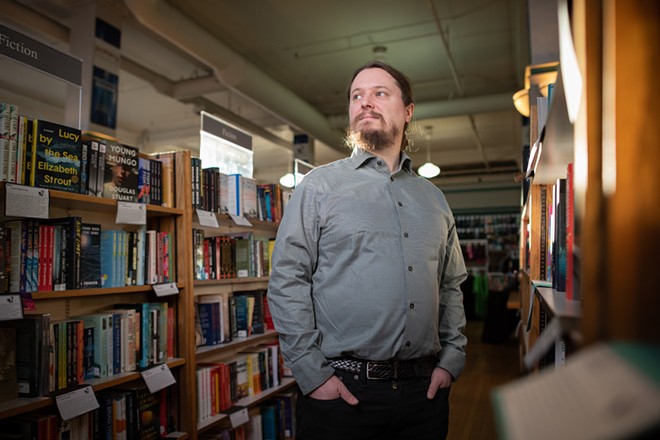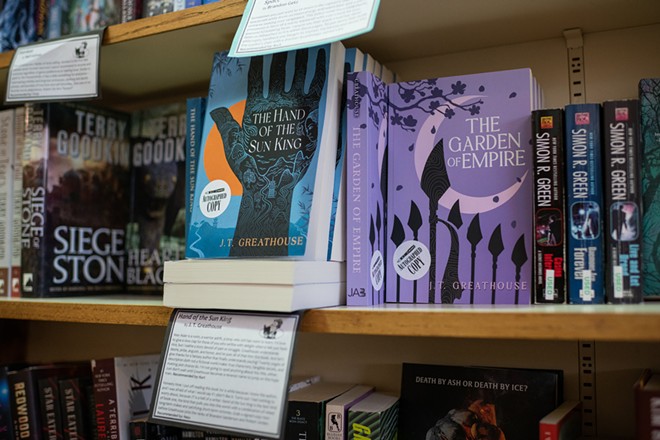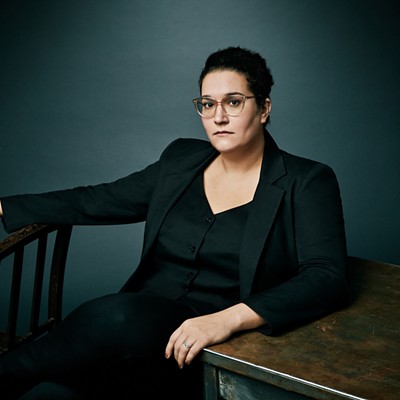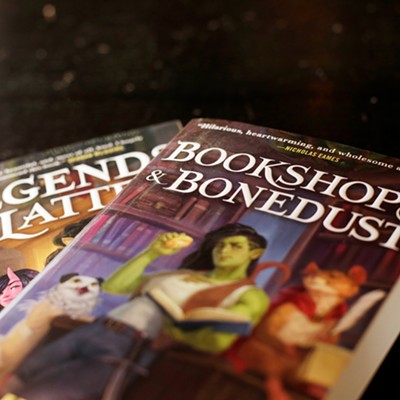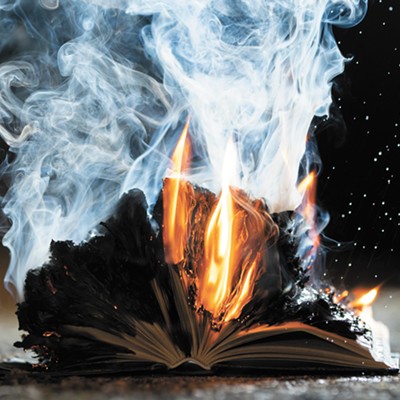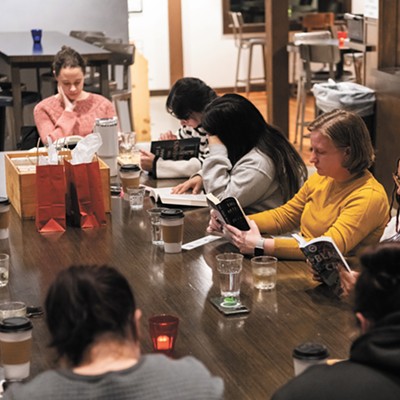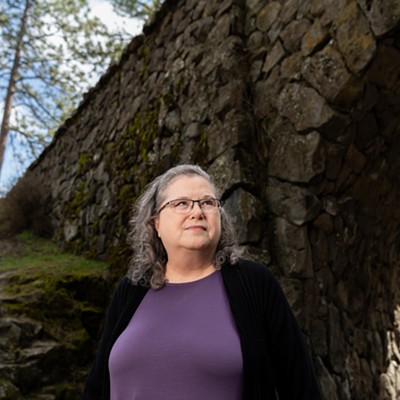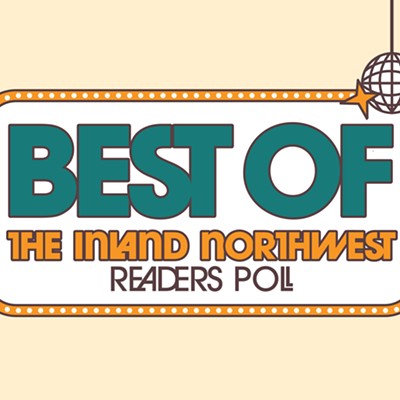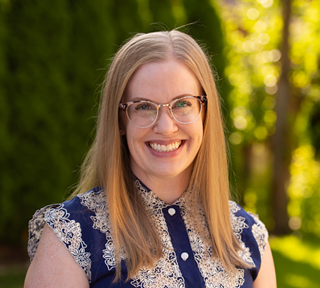Jeremy TeGrotenhuis has been furiously writing since he was 11 years old. Spinning up fantastical worlds and characters, plucking them from his imagination, and breathing it all to life via strings of words, sentences and, eventually, 400-page novels.
Under his pen name, J.T. Greathouse, the Tri-Cities native and Whitworth University graduate has so far published the first two books of a three-part fantasy trilogy. The Hand of the Sun King was released in mid-2021, followed by the second title, The Garden of Empire, which came out summer 2022. The third and final title, The Pattern of the World, is expected later this year, wrapping up TeGrotenhuis' Pact and Pattern series.
"I joke that I went from the learn-to-read, easy things to the Animorph books to The Hobbit, and from there I was reading Dune in middle school," says TeGrotenhuis, 30, who's called Spokane home for the better part of the last decade. "So, a lot of reading at a pretty high level from a young age, and a lot of just writing for the fun of it."
As a high school freshman, he was encouraged by his teachers and mother, who taught English, to enter a short story contest put on by the Columbia Basin College in Pasco. He got second place in his division. He again placed among the top contestants each of the following years before enrolling at Whitworth.
"That was kind of validating to be like, this is a thing that I'm good at, right?" he recalls. "So that was what kept me moving forward, and then I started taking writing more seriously in my 20s, trying to sell short stories to places."
His short stories have been published in Writers of the Future Volume 34, Beneath Ceaseless Skies magazine, Orson Scott Card's InterGalactic Medicine Show anthology, and others.
In his 20s, TeGrotenhuis also wrote novels "just for fun," but among those early projects, none, he says, were "publishable" until he landed on The Hand of the Sun King. It was picked up by the U.K.-based publisher Gollancz, which signed him on for a three-book contract, a typical span for sci-fi and fantasy books since J.R.R. Tolkien's The Lord of the Rings paved the way back in the 1950s for the genre's modern landscape.
"I am friends with a few other writers who feel a lot of angst about getting published, or staying published, and I experienced some of that, but I also would be [writing] anyway," TeGrotenhuis says. "I was doing it when I wasn't trying to sell anything, and I will continue doing it even if I can't publish stuff."
When he's not writing, TeGrotenhuis teaches English and philosophy at Spokane's Innovation High School and works as a part-time bookseller at Auntie's Bookstore. The perk of that job, he says, includes an employee discount to help feed his avid reading habit, but he also gets to see who around town is buying his books — Auntie's is one of only a handful of local stores where it's available and, of course, all copies there are signed.
I n TeGrotenhuis' first novel, The Hand of the Sun King, readers meet protagonist Wen Alder, a boy living in the Empire of Sien, on the island of Nayen — a fictional land loosely based on the actual geography, history and cultures of China.
To live up to his father's expectations, Alder is studying for the imperial exams with hopes of going into the service of the Emperor, a revered and fearsome, god-like being. On his mother's side, however, Alder's bloodline descends from a powerful class of witches whose magic and culture have been stolen from them by the Empire. Alder's grandmother secretly teaches him how to harness this magic before disappearing to join a rebellion of other witches led by his uncle. Alder still longs to harness the magical elements of his world, so he chooses a path that largely sees him conforming to the Empire's rule in exchange for this knowledge.
"The central, core idea of the whole series was this concept and experience that many post-colonial writers would talk about, where you're a member of a colonized population who is part of the sort of rarified group of people that get to go study" from those who oppressed you, TeGrotenhuis explains.
This theme was directly informed by his own undergraduate studies at Whitworth focusing on history and philosophy. He also studied abroad in China for a semester.
"It was all stuff that we talked about in my senior seminar and history class that I thought was super fascinating, so that was the germ of the novels," he continues. "I was like, I want to write about a character who's educated by the empire that conquered his homeland."
While that theme of the novels was inspired by history, specifically China's Ming dynasty, the otherworldly elements of Alder's world should also feel familiar to fantasy fans. In Sien, the witches among its different factions of people are able to control various elements of nature (some use fire; others wind, water, earth, etc.), communicate telepathically and even heal.
"I had a friend who's a huge Avatar: The Last Airbender fan point out to me: 'You're just doing Avatar,' and yes, I guess I am, but we both drew from the same actual facets of Chinese philosophy, which is the Wuxing five elemental phases concept," TeGrotenhuis says.
While the first book focuses on Alder's coming of age as he begins to question the structure of the world he lives in, the second is a broader view of the struggle between the oppressed and their oppressors, and the moral challenges that arise on both sides during a violent struggle for independence or control.
The final, forthcoming book, TeGrotenhuis says, "is largely about when you realize a system that you rely upon, or that is sort of integral to your society, is inherently broken. And what do you do next?"
Carrying readers along on this magical, philosophical journey are a cast of realistically flawed characters beyond just Alder who are faced with plenty of difficult decisions, and whose actions directly impact the future of those around them.
"I really like that kind of story dynamic where the main tension, like in The Hand of the Sun King, is a war between the empire and the rebellion, and there's other things going on, external conflicts and external tensions. But the core of all three books is internal tension," TeGrotenhuis says.
"It's a person who has a question about who they are, or a question about what they value, and then they're trying to decide where they land. I think that's more realistic. It's more relatable." ♦

